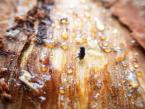“And now, here they are: the beetles!” (Insert soundtrack of hysterical screams.)
Don’t faint, and don’t expect to see Paul, Ringo, George, and John — the beetles that I am talking about are the ones you would have had a much better chance of seeing in the past few weeks.
Ladybugs — more accurately called lady beetles, if you speak the language of the entomologist — have been a surprising sight recently to those who imagine they only appear in the lazy days of summer. There is nothing lazy about lady beetles, or any reason to think of them as a uniquely summer phenomenon.
Still, Here Comes the Sun, Good Day Sunshine, or I’ll Follow the Sun could certainly be their theme song. Since these insects can fly only when the temperature is at least 55 degrees Fahrenheit, we find them in great numbers on warmer days, even if those days happen to be in November. When it’s warm, they swarm.
There is an interesting story behind their name. They were named in Europe during the Middle Ages. Insects were destroying crops, and Catholic farmers prayed to the Virgin Mary for help. Soon enough, the lady beetles came and ate the offending insects. The farmers thanked the “beetles of our lady,” and from that came the name lady beetles. The red of their wings symbolized the Virgin’s cloak, and the black spots her joys and sorrows.
They choose to alight here, there, and everywhere around your humble abode not necessarily because you are a good host or because you have a jar of aphids in the pantry. They are attracted to the white trim, ceilings, and walls of your residence, and can hibernate in cracks and crevices. The reason for this is that white or light-colored surfaces are reminiscent of the limestone outcroppings that the beetles remember from the old country — which isn’t England, by the way: lady beetles are not a British invasion, but one from Asia. Although we do have native lady beetles, many of the ones that we see in our homes are an introduced variety, the Asian lady beetle.
Asian lady beetles first came to America in the early 1900s. They were brought here by the United States Department of Agriculture (USDA), which imported them to combat aphids on fruit trees. It is believed that this first population didn’t survive. Perhaps they had to get back to where they once belonged.
It might have been an accidental importation on cargo ships that brought the second wave of Asian lady beetles to our shores on another world tour. Or, it might have been another intentional introduction, this time to combat aphids in pecan groves. The USDA, after all, had been correct: lady beetles are exceptionally effective at reducing pests in fruit and nut groves. One adult beetle can eat 50 aphids a day, or 5,000 aphids during the course of its lifetime.
In fact, they are so effective that, since they arrived, pesticide use in pecan groves has been estimated to have been reduced by 50 to 75 per cent! Good work, ladies (and lads, since lady beetles, of course, come in both genders)!
Add to their voracious appetite and pest-fighting finesse the lady beetle’s reproductive ability, and you have a true star of the insect world. Like their namesakes, these beetles are prolific: each female lady beetle lays more than 1,000 eggs in her lifetime.
To “Get Back” to the ones on your house: these household guests (or pests, depending on your perspective) are staying for a while. They have come to your house to overwinter, and they will tell all of their friends (“All Together Now”). As they settle into a comfortable spot, they release pheromones to tell others to come to the party — like a teenager with a cell phone and parents away for the weekend. The gathering grows quickly.
While this allows great numbers of beetles to congregate, they do no damage to your home, unless your aggression gets the best of you. If you Let It Be, the beetle will simply fly about and return to its wintering spot
If, however, you try to get rid of it, be warned that squashing lady beetles is a bad choice. Their yellow blood is malodorous and can stain your walls and furniture. Instead, try vacuuming them up, if you insist on not sharing your habitat. A shop-vac is recommended, because it can catch them without doing much damage. Release them into the yard and garden — with or without the invocation, “ladybug, ladybug, fly away home.” They are your friends and will, in season, eat your pesky aphids.
If you can cohabitate, consider them a good omen. They are reputed to bring good harvests, ward away sickness, promise impending marriage, and bring cash. Look for the ones with fewer than seven spots, for those with more than seven are supposed to bring famine. Throughout history, they have been seen as beneficial insects, for the most part.
Whether you are happy or sad about the presence of lady beetles depends on whether you think more like a gardener or like a pest-free housekeeper. The gardener knows that we get by with a little help from our friends.






Comments
Comment policy »